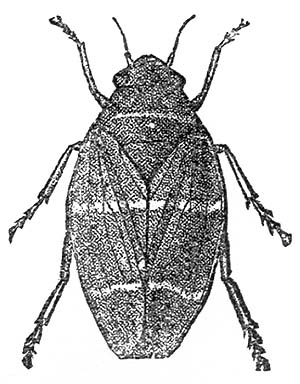
BUG OF THE MONTH: June 1996
Spittlebugs
Order Homoptera, family Cercopidae
Copyright © 1996 by Louise Kulzer
This article originally appeared in Scarabogram, June 1996, New Series No. 194, pp. 2-4.
 |
| Spittle mass on plant stem |
Most people are at least mildly familiar with these curious bugs. Spittlebugs earn their name from the small patches of foam or "spit" they create along the stems of plants and meadow grasses in late spring and early summer. Spittlebugs are in the order Homoptera, the same as cicadas and aphids, which is closely related to the true bugs, order Hemiptera (a.k.a. Heteroptera). Close enough for us to call them "bugs" with heads held high.
It is the immature bugs, or nymphs, that create the spittle while feeding on plant sap. Adult bugs feed on plant sap too, but with better manners and no spit. Hence, most people cease to notice spittlebugs when they mature. Adults are often called froghoppers. They exhibit the astounding ability to leap great distances in a single bound. They look real cool too (see below).
When they feed, spittlebugs puncture the plant stem facing head downward. (Don't take my word for it! Blot away the foam and see for yourself!) Sap is pumped through the body and expelled through the anus at a rapid rate (Wiegert 1964). Some folks think that as the fluid is excreted, it is mixed with air in a special abdominal chamber into which a number of spiracles open (Milne & Milne 1980). Kind of like foaming milk for your expresso. However, other folks think that the air is introduced externally as the sap drips down over the abdomen. Having watched these guys intently for a few hours, I myself think they do the foaming externally. What do you think? [According to Borror & DeLong, the air is "introduced...by the caudal appendages"; according to Howard (1903), by "constant thrashing about of the anal and of the body"! --editor]
Intrepid investigators have also suggested that the fluid probably contains secretions that enhance surface viscosity and stabilize the foam, making it last longer (Marshall 1966). What Starbuck's wouldn't do for this information, huh?
 |
| Adult cercopid, Monecphora bicincta |
Foaming the plant sap has advantages for the young spittlebug. First of all, the foam hides it from predators who may be reluctant to get a snoot full of goo just to eat the plump morsel within. Secondly, the foam offers the ultimate in air-conditioned comfort and protection from desiccation by providing constant, high humidity environs insulated against temperature extremes. In fact, spittlebugs have a notable lack of moisture conserving adaptations in the nymphal stage. Geez, the cuticle isn't even hard!
Spittlebugs are a bit life-style eccentric among insects that suck plant sap. This is because they feed on the xylem, the tissue that transports water from the roots to the shoots. Most sap feeders choose the phloem, the tissue that transports food from the leaves (remember the alliteration, phloem=food, from a former-life biology class).
Now as you might suspect, the xylem is not nearly as rich in food as the phloem, since it is the leaves that manufacture the sugars for the plant (Horsfield 1977). The spittlebug must therefore process large quantities of sap to meet its nutritional needs, getting its sustenance almost solely from amino acids (that would be a little bit like people living solely on squid!)
Now, here's the interesting part. The more amino acids in the xylem, the better the spittlebugs survive (Horsfield 1977). Recently, a review of food plant preferences of spittlebugs revealed that a high percentage of native food plants are nitrogen fixers (Thompson 1994). Legumes, nitrogen-fixing grasses, and plants with symbiotic nitrogen-fixing bacteria are used by spittlebugs far more often than if their food plants were selected ramdomly.
Now, I predict that there is also a relationship between the number of different plant species spittlebugs feed on and the general fertility of garden soil! If this is true, it means that having lots of spittlebugs is a compliment! You should be proud to have lots of spittlebugs, for goodness' sake!
Wow. Doesn't this make you want to run out and record all the plants in your garden or meadow that have spittlebugs on them? Find out which plants are nitrogen fixers? Look up the probability that spittlebugs are selecting their food plants randomly, without respect to nitrogen status? Put in your two cents about Thompson's theory? Entomology lives; science rules!
[Another interesting question: are all froghoppers spittlebugs? Many references (e.g. Borror & DeLong 1971) imply they are; according to Howard (1903) it is just the subfamily Aphrophorinae...]
References
Borror, Donald J. & Dwight M. DeLong. 1971. An Introduction to the Study of Insects. 3rd [best] edition. Holt, Rinehart, & Winston.
Horsfield, D. 1977. Relationship between feeding of Philaenus spumarius (L.) and the amino acid concentration in the xylem sap. Ecological Entomology, 2: 259-266.
Howard, L.O. 1903. The Insect Book. Doubleday.
Marshall, A.T. 1966. Spittle-production and tube-building by cercopid larvae (Homoptera). IV. Mucopolysaccharide associated with spittle production. Journal of Insect Physiology, 12: 635-644.
Milne, Lorus J., and M. Milne. 1980. Insect Worlds. Ch.4, Survival of the prey. Scribner, New York.
Thompson, Vinton. 1994. Spittlebug indicators of nitrogen-fixing plants. Ecological Entomology, 19: 391-398.
Wieger, Richard G. 1964. The ingestion of xylem sap by meadow spittlebugs, Philaenus spumarius (L.). American Midland Naturalist, 71(2): 422-428.
This page last updated 16 June, 2005